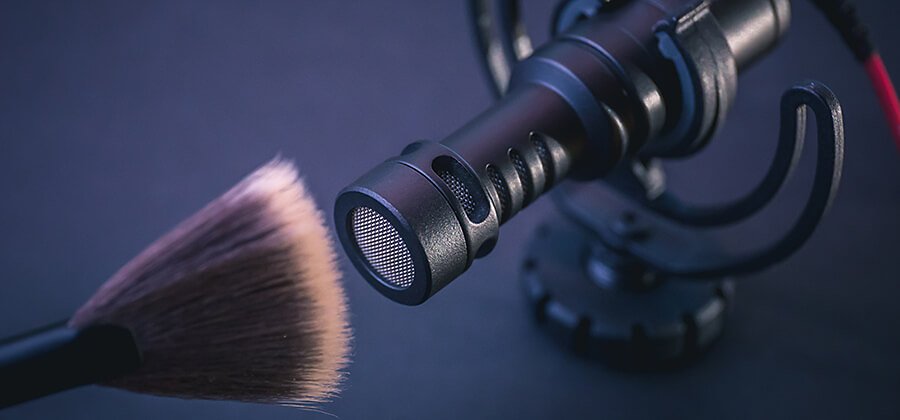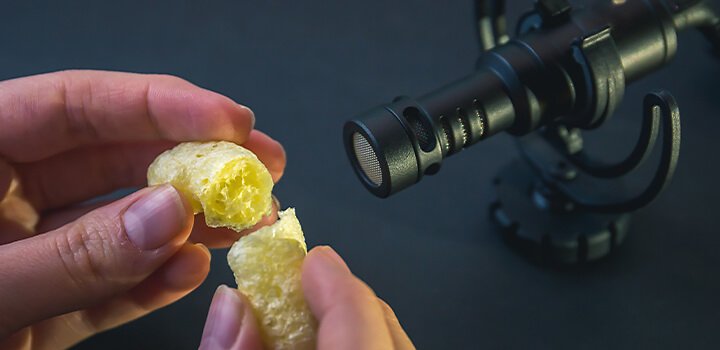What ASMR is and how to build a YouTube following.
Millions of people seek out ASMR (Autonomous Sensory Meridian Response) videos to help them relax or fall asleep. Learn how to create an ASMR video that calms and comforts.

What is ASMR?
Autonomous sensory meridian response is both a psychological and physical experience. It includes feeling calm, happy, and sleepy, as well as experiencing a tingling sensation on the scalp and down the back of the neck and spine. People tend to experience ASMR when they feel a light touch, see a smiling face and gentle hand movements, or hear trigger sounds like gentle whispering, the soft crinkling of paper, rubbing of fingers, or the quiet smacking of lips.
Though the term ASMR has been around for only about a decade, audio and video that relaxes, reduces heart rate, and causes brain tingles has been around for much longer. The painter Bob Ross is considered an early ASMRtist (the term now used for ASMR artists). Millions of people still go to YouTube for his soothing voice and the soft scrape of his brushes and knives against the canvas, though most have no intention of painting happy little clouds and trees.
We don’t yet know exactly how ASMR works on the brain, but people who are sensitive to these sights and sounds credit ASMR videos with helping them fall asleep, reducing their anxiety, and even treating PTSD and chronic pain symptoms.
Not everyone reacts to the same ASMR stimuli (and some people react negatively to them), but so many people enjoy them that “ASMR” is one of the top YouTube search terms. The most popular ASMRtists, like Gibi ASMR and ASMR Darling, have over two million subscribers to their YouTube channels.

The basics of ASMR video.
ASMR videos range in length from 15 minutes to 4 hours, but most are between 20 and 40 minutes long. Unlike most video entertainment, the goal is to relax viewers and put them to sleep. Therefore, the only absolute rule is that movement in the frame be slow and deliberate and audio be quiet and smooth. You can talk about anything, read a book, whisper unintelligibly, brush a doll’s hair, even eat messy food in close-up. You just have to do it slowly and deliberately and avoid making any loud noises.
Role-playing is common.
Because ASMR is both physical and psychological, ASMR videos and podcasts often include role-playing as well as whispering, gentle facial expressions, and slow movements. Popular role-playing scenarios tend to be based on real-life experiences of being cared for in safe environments with quiet sounds. The most common are trips to the spa, hair salon, or doctor’s office. ASMRtist Karuna Satori says many people experienced ASMR for the first time as children while being examined by doctors. The gentle touching and caring tone of the doctor caused the head tingles and safe, sleepy feeling.

Equipment doesn’t matter as much as how you use it.
You don’t need anything special to start shooting and uploading your own ASMR video. Some ASMR celebrities might use high-end binaural microphones that transmit separate sounds to the left and right ears, but most use the affordable Blue Yeti. You can even start with the built-in microphone on your phone. Karuna Satori uses a Blue Yeti, but sometimes she still makes “lo-fi” videos with her iPhone’s mic. The main thing, says the ASMRtist known as ASMR Glow, is to “pay attention to everything you do. Even if you take a single step, it’s going to make a lot of noise.” Of course, you can always edit out bad takes or accidental noise with Adobe Premiere Pro after you’ve shot your video.
Lighting throughout these videos varies, but ASMR Glow recommends keeping the lights low, since “people are trying to relax and fall asleep.”
As far as cameras go, Satori and ASMR Glow shoot their videos with their iPhones on tripods. “My camera is always on a tripod, but I really play with the angles because if the camera is from below, I feel like it’s more reassuring, more comforting,” ASMR Glow says.
You can record these videos anywhere that’s quiet (Satori records in her mother’s attic), and you can treat your home recording studio to minimize outside sounds.
Being yourself matters the most.
The ASMRtists who build the biggest followings do so not because of high production value, but because they build a relationship with their audience. Viewers begin to feel like they know them, and that familiarity allows them to relax more easily with every video. “The more you make a person feel like they’re included, the more they’ll stick around and form a trust. The more open you are — the more real — the better,” says Satori.
As with other arts, when you’re starting out, the important thing is to discover your own unique voice. “Always focus on yourself at first,” Satori says. “Once you start building an audience, then you can start listening to them.”
Create the content you want to see.
Try to recall the ASMR triggers you’ve experienced and recreate them on camera. Odds are other people out there can relate. “Do what makes you feel relaxed,” Satori says. “I always work off of triggers and situations that have happened in my life because everybody’s different.”
ASMR Glow offers similar advice: “Stand out and be as creative as possible. Really put your personality in your videos. Even if you think an idea is crazy, you should try it. Be bold.”

What to do when people ask if it’s sexual.
Tell them it’s usually not. Part of this misconception arises from early descriptions of the sensation including terms like “brain orgasm.” Sexual ASMR is a whole separate genre, Satori says. “But ASMR in itself is not sexual. It’s a simple feeling.”
“It’s about intimacy, not sex,” ASMR Glow says. “It gives health benefits to so many different people in so many different ways, so why categorize it like that?”
A final piece of advice: When you get in front of the camera, try to be as relaxed and calm as you want your viewers to feel. Be yourself, recall your first or best ASMR experiences, and project that peacefulness, that gentleness out into the world.
Then, edit your ASMR video on your phone or computer, and share to YouTube, Instagram, or other popular social channels. Who knows? Maybe you’ll whisper your way into becoming the next ASMR celebrity.
Contributors
Do more with Adobe Premiere Pro.
Make visually stunning videos virtually anywhere — for film, TV, and web.
You might also be interested in…
Introduction to video editing.
Learn the principles of video editing and practical tips for both big and small screens.
Understanding camera shots in film
Explore the most common camera shots, and learn when and how to use them to greatest effect.
Setting up a home recording studio.
Explore the basics of creating a space at home to capture high-quality audio.
Finding the best DAW for your audio needs.
Learn how to select a music or podcast mixing platform to meet.
Get Adobe Premiere Pro
Create flawless productions with the industry-leading video editing software.
7 days free, then US$ 22,99/mo.



